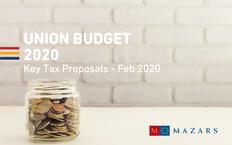Union budget 2020 I Key tax proposals
This year’s budget is centered upon increasing national well-being – on both a macro and micro level – along with improving the ease of living for every individual. In order to achieve this, the government envisions to capitalize upon the ongoing technological spree, along with India’s favorable demographic dividend and models of good governance, envisioning development around three prominent themes:
- Aspirational India, in which all sections of the society seek better standards of living, with access to health, education and better jobs. Areas such as agriculture, irrigation, rural development, wellness, water, sanitation, education and skill-setting are given due importance.
- Economic Development for all, which entails taking reforms across swathes of the economy and yielding more space for the private sector. Accordingly, a host of industries, investment opportunities and infrastructural development receive great attention.
- Caring Society, which focuses on being humane and compassionate. Focus here is on promoting India as a women-friendly and socially-responsible nation, which strives upon protecting its environment, history and heritage, alongside promoting tourism.
The output for farmers is high, with the Finance Minister drawing upon a 16-point action plan to boost their earnings. This plan not only covers avenues in agricultural land leasing and livestock marketing, but also touches upon new-age measures such as removing farmers’ dependence on diesel and kerosene and encouraging them to turn their barren lands into solar generating pump sets. Similarly, the impetus on building efficient cold supply chains and warehousing, coupled with integrated farming systems, availability of agro-credit and maritime marketing, should sway in unprecedented momentum into one of the nation’s most pertinent sector.
Educational reforms are also in the picture, given India will have the world’s largest working population in 2030. The upcoming New Education Policy will revamp the nature of knowledge delivery, which needs to be set amidst a backdrop of talented teachers and enthusiastic students. The government has thereby allocated INR 99,300 crore for the education sector and INR 3,000 crore for skill development in 2020-21.
Electronics Manufacturing has been identified as a key sector for shaping India’s further economic trajectory, with the government set to encourage the manufacture of mobile phones, electronic equipment and semi-conductor packaging “in-house.” The country is also envisioned to become a global export epicenter, with schemes such as NIRVIK aiming to achieve higher export credit disbursement. This will be done through higher insurance coverage, reduction in premium for small exporters and simplified procedure for claim settlements.
Infrastructure continues to stay at the forefront, with transport infrastructure alone receiving an outlay of INR 1.7 lakh crore. At least 12 lots of highway bundles, running over 6,000 km, are proposed to be monetized before 2024. Alongside this, measures to upgrade national railways through the setting up of large solar power capacities, station re-development, high-speed trains, Tejas connectivity etc., coupled with the construction of new airports, will not only boost national logistics but also build upon Indian tourism on a global scale.
Whilst these are just few of the various changes enshrined throughout the national economic facet, they are all bound with the overall objective to lead India in its next phase of digital revolution. Both disruptive technologies and innovative ideas around such technologies – ranging from Artificial Intelligence, Data Analytics, Quantum Computing and much more – are envisioned to be strategically disseminated throughout the country. The story is not just about digitizing payments or transactions, but also running into e-education, e-tax assessments & faceless appeals, e-registrations etc. Startup and MSME-friendly practices continue to be given due limelight in this regard, given their critical roles in garnering India towards new channels of development.
On an individual scale, the revision of personal tax slabs has gathered much frenzy, with many taxpayers – or the “common middle-class man” – benefiting under reduced rates in the INR 5 lakh to INR 15 lakh bracket. However, the question remains whether those utilizing the current slew of deductions in the old regime, will be able to forgo and opt for a face-value, simplified structure in the new one. This will be more of a personal choice rather than a regulatory mandate.
Having said this, this is not to say the budget did not meet its share of debate. The market portrayed mixed sentiment, with the Sensex and Nifty having their own highs and lows, both during and after budget delivery. Whilst projections on a 10% GDP growth ahead and plans on LIC divestment kicked in unparalleled optimism, the absence of long term capital gain coverage and dividends being taxable in the hands of investors, led to negative emotions. Nevertheless, the fiscal deficit pegged at 3.5% for 2020-21, remained in-tact with market expectations.
On the same lines, some believe the budget has been more about setting in visionary elements across the economic spectrum, as opposed to covering the operational management of reforms. Nevertheless, this was expected, given that this budget is not just about penning down a 12-month fiscal timeline but spearheading long-term reforms that will span throughout the decade. It is to be seen exactly how this three-pronged thematic budget steadily comes to fruition, with the operational mind-map for each goal coming out steadily in the picture.

